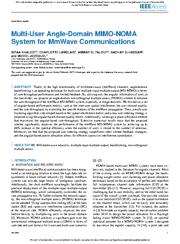Multi-User Angle-Domain MIMO-NOMA System for MmWave Communications
Israa Khaled, Charlotte Langlais, Ammar El Falou, Bachar ElHassan, Michel Jezequel
2021
IEEE Access
Thanks to the high directionality of millimeter-wave (mmWave) channels, angle-domain beamforming is an appealing technique for multi-user multiple-input multiple-output (MU-MIMO) in terms of sum-throughput performance and limited feedback. By utilizing only the angular information of users at the transmitter, we propose an angle-domain non-orthogonal multiple access (NOMA) scheme to enhance the sum-throughput of the mmWave MU-MIMO system, especially in congested cells. We first derive a set of
more »
... ngular-based performance metrics, such as the inter-user spatial interference, the user channel quality, and the sum-throughput, by exploiting the specific features of the mmWave propagation. Then, a multi-user clustering algorithm is developed based on the spatial interference metric, and a new user ordering strategy is proposed using the angular-based channel quality metric. Additionally, we design a power allocation method that maximizes the angular-based sum-throughput. Extensive numerical results show that the proposed scheme significantly improves the performance of the mmWave MU-MIMO system by achieving up to 39% increase in the spectral efficiency when the number of users is closed to the number of antennas. Moreover, we find that the proposed user ordering strategy outperforms other limited feedback strategies, and the angular-based power allocation allows for efficient successive interference cancellation. INDEX TERMS Millimeter-wave networks, multiple-input multiple-output, beamforming, non-orthogonal multiple access. VOLUME , 1 The user's spatial angle w.r.t. the BS represents the angle-of-departure (AoD) of the LoS path and is a slowly time-varying CSI compared to the other CSI components. This information can be estimated and tracked with standard AoDs estimation algorithms such as [21], [22] at the BS or the receiver side. If the users estimate this information, then they send it back to the BS. 2 In our previous work [23], we investigate the angle-domain (AD) MIMO-NOMA scheme with only two users within the NOMA cluster in a monopath environment. A 2-user clustering algorithm is developed, and a fixed power allocation method is applied for the two NOMA users.
doi:10.1109/access.2021.3112225
fatcat:joiwkcquire4tdro6s4czitxpy

